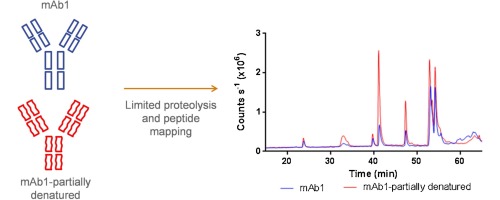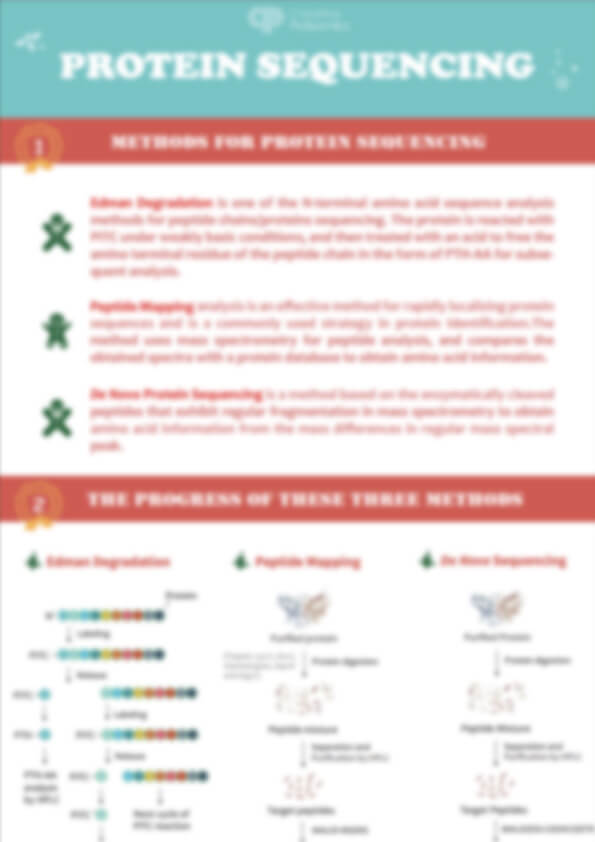What Is Peptide Mapping
Peptide mapping, a technique based on the coupling of liquid chromatography and mass spectrometry (LC-MS), serves as a method for identifying and quantitatively analyzing peptides (short amino acid sequences) in complex samples. This analytical approach involves the separation, identification, and quantification of peptide molecules within a sample, thereby offering insights into the composition, abundance, and structural information of peptides present. Peptide mapping finds crucial applications in fields such as biological research, clinical diagnostics, and drug development. It aids researchers in understanding processes such as protein degradation, modifications, and interactions, as well as in discovering new biomarkers or drug targets.
Peptide mapping represents a primary technique for determining the primary structure (amino acid sequence) of proteins. Moreover, it serves as a vital means for quality control of protein peptide-based drugs, contributing to drug development and the entire production process. Not only can it facilitate comparisons between recombinant and native protein outcomes, assess post-translational modifications in recombinant products, and identify variations in unknown amino acids, but it also allows for the comparison of peptide maps from different batches of products to validate the stability of the manufacturing process. Therefore, in the realm of protein-based drugs, peptide mapping carries significant importance for structural studies and attribute identification, establishing itself as a routine criterion for quality control in protein peptide-based drug standards. For recombinant protein drugs, such as monoclonal antibodies (mAbs) and antibody-drug conjugates (ADCs), peptide mapping plays roles in identification, primary structural characterization, and quality assurance/quality control (QA/QC). Several global regulatory agencies, including the U.S. Food and Drug Administration (FDA) and the European Medicines Agency (EMA), have formulated guidelines mandating the submission of peptide maps to confirm the amino acid sequence of active pharmaceutical ingredients.

Application and Significance of Peptide Mapping
Mass spectrometry-driven peptide mapping provides a wide range of insights into the foundational architecture of a protein, spanning the subsequent dimensions:
Confirmation of Amino Acid Sequence: Peptide mapping serves to affirm the amino acid sequence of the protein. By pinpointing the masses of the produced peptides, one can ascertain the accuracy and integrity of the sequence.
Unveiling Post-Translational Modifications (PTMs): This method accurately identifies a spectrum of modifications appended to the protein, encompassing phosphorylation, glycosylation, acetylation, methylation, and more. Precise localization and classification of modifications unveil functional roles and possible implications.
Detection of Protein Variants: It discerns genetic variations or proteoforms of the protein, including single amino acid polymorphisms (SAPs) and alternative splicing events.
Exploration of Disulfide Bond Arrangement: By elucidating the presence and configuration of disulfide bonds, deeper insights into the protein's higher-order structure and stability are gained.
Comprehensive N- and C-Terminal Verification: Identification of terminal residues furnishes a holistic comprehension of the protein's boundaries and structure.
Evaluation of Proteolytic Cleavage Sites: By identifying protease-specific cleavage points, it enables the assessment of the protein's susceptibility to enzymatic degradation.
Tracking Degradation Products: Detection of products arising from proteolysis or chemical degradation aids in the surveillance of protein stability.
Quantitative Insights into Modifications: Leveraging mass spectrometry, modifications are quantified, offering insights into their relative prevalence and potential functional importance.
Exploration of Crosslinking: In select scenarios, crosslinked peptides offer glimpses into protein-protein interactions and structural assembly.
Comparative Exploration: Peptide mapping facilitates the comparison of distinct samples, including diverse protein batches or samples subjected to varying conditions, revealing differences in sequence, modifications, or other structural attributes.
Ensuring Quality Control: This technique acts as a stringent quality control measure, guaranteeing the uniformity and integrity of protein batches.
Peptide Mapping Service at Creative Proteomics
At Creative Proteomics, we have developed a liquid chromatography with tandem mass spectrometry (LC-MS/MS)-based peptide mapping platform for confirmation of protein primary structure. And we can provide the peptide mapping service to analyze the sequence of biopharmaceuticals and confirm complete expression of recombinant protein in compliance with ICH Q6B.
 Figure 1. Workflow of Peptide Mapping Service at Creative Proteomics
Figure 1. Workflow of Peptide Mapping Service at Creative Proteomics
As peptide mapping service compares the peptide masses with protein databases, only proteins from the database can be identified using this method. Proteins, whose sequence is not found in a protein database, such as antibodies or novel proteins, can be deduced by our service of de-novo sequencing. In addition, we can provide detailed reports, including:
Experiment procedures
Parameters of liquid chromatography and mass spectrometer
MS raw data files
Bioinformatics analysis
Peptide mapping results
Peptide Mapping Services Content
Our peptide mapping service can help clients to comply with ICH Q6B guidelines in support of marketing applications. Our peptide mapping service, based on UPLC-MS/MS technology, offers the following capabilities:
- Confirmation of the primary structure of proteins (amino acid sequence, including N-terminal and C-terminal)
- Identification of modification sites and their proportions on proteins, such as deamidation, oxidation, N-terminal pyroglutamic acid, C-terminal lysine clipping, and glycosylation.
- Qualitative and quantitative information about protein degradation products
- Glycopeptide analysis for identifying glycosylation sites
- Reductive and non-reductive peptide mapping to characterize disulfide bond connections.
Our Advantages
- Various types of proteases used to achieve coverage of 100%, such as trypsin, chymotrypsin, Asp-N, Glu-C, Lys-C, and Lys-N.
- Professional peptide mapping platform including advanced instrument and software.
- Protein sample 100% sequence validation service.
- Delivery of detailed report in a fast turnaround time.
- Quantitative detection limit for amino acid mutation sites is achieved down to 0.1%.
- Translationally modified types and quantitative results can be provided.
Technology Platform
High Performance Liquid Chromatography (HPLC)
Matrix Assisted Laser Desorption Ionization Mass Spectrometry (MALDI-MS)
Peptide Mapping workflow
Sample Preparation:
Reduction and Alkylation of Proteins: This step aims to reduce disulfide bonds in proteins while preventing the generation of free thiols through alkylation. Reducing disulfide bonds helps to open up the protein's structure, facilitating more efficient enzymatic digestion of proteins. For proteins with interchain disulfide bonds (e.g., monoclonal antibodies), this step also disrupts interchain linkages.
Enzymatic Digestion of Proteins:
Specific enzymes are used to break down proteins into peptide fragments. The choice of enzyme is based on the theoretical protein sequence and enzymatic digestion knowledge. Strategic enzyme selection achieves optimal results for peptide mapping analysis.
Peptide Mapping and Glycopeptide Analysis:
Enzymatically digested peptides are analyzed using online reversed-phase high-performance liquid chromatography (RP-HPLC) coupled with a UV detector. Peptides are separated based on polarity using liquid chromatography (reversed-phase). In the mass spectrometer, mass information for each eluted peptide fragment is generated.
Mass Spectrometry Analysis:
Mass spectrometer generates mass spectrometry data for peptide fragments, including mass and fragmentation information. Fragment ion information is used to determine the amino acid sequence of peptide fragments. Mass spectrometry analysis can be performed using either selective tandem mass spectrometry (MS/MS) or non-selective tandem mass spectrometry (MSe), depending on research requirements.
Data Analysis:
Mass spectrometry data is processed and interpreted using specialized software. Confirmation of peptide amino acid sequences and possible modifications is achieved by comparing the data with known peptide databases.
Quantitative Analysis:
Using the mass spectrometer's quantitative modes (such as MRM or SIM), the abundance of target peptides is quantified. Quantitative analysis is performed based on standard curves or internal standards.
Interpretation of Results:
Combining data analysis and quantitative results provides information about the composition, structure, and abundance of peptide molecules in the sample. Comparison with other samples allows for assessment of similarities, differences, and equivalencies.
Understanding Protein and Peptide Structures through Enzymatic Peptide Mapping
Peptide mapping analysis is based on the characteristics of protein and peptide molecular weight and amino acid composition. It involves the use of highly specific proteolytic enzymes (typically endopeptidases) to cleave peptides at specific peptide bond sites, resulting in fragment patterns that form characteristic fingerprints. For in-depth analysis of enzymatic digested peptide samples, a high-resolution, sensitive, and accurate mass spectrometer is essential. High-resolution mass spectrometry provides high-quality primary and secondary spectra for enzymatic fragments. Specialized software enables rapid, accurate, and in-depth analysis of peptide mapping data. Certain proteolytic enzymes can cleave protein backbones, usually acting on specific amino acid residues, such as:
| Enzyme | Specificity | Characteristics |
|---|---|---|
| Trypsin | Acts on the carboxyl side of lysine (K) and arginine (R) | Generates an average of one peptide per 10-12 amino acids. Trypsin is the most commonly used protease for protein digestion. |
| Lys-C | Acts on the carboxyl side of lysine (K) | Can generate 60-70% of peptides that trypsin would produce in protein digestion. Lys-C's advantage is its ability to maintain activity in up to 4M urea concentration. |
| Staphylococcus aureus V8 Protease (Glu-C) | Acts on the carboxyl side of aspartic acid (D) and glutamic acid (E) | Provides complementary information to trypsin digestion. |
| Asp-N | Acts on the amino side of aspartic acid (D) | Provides complementary information to trypsin digestion. |


















